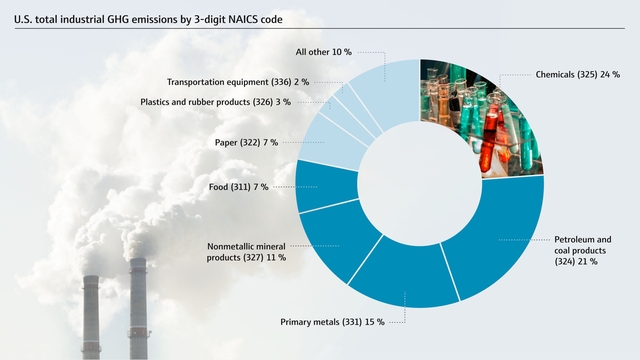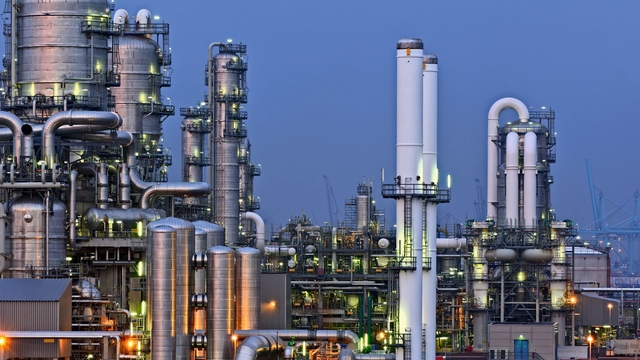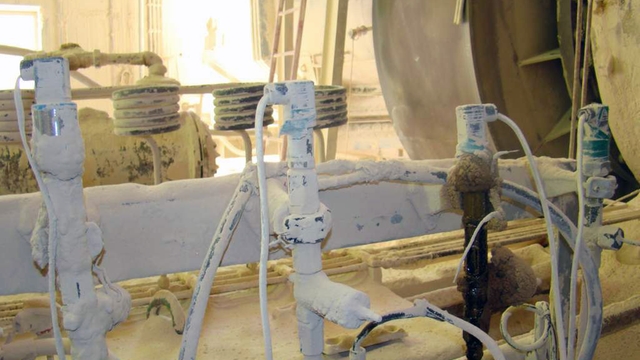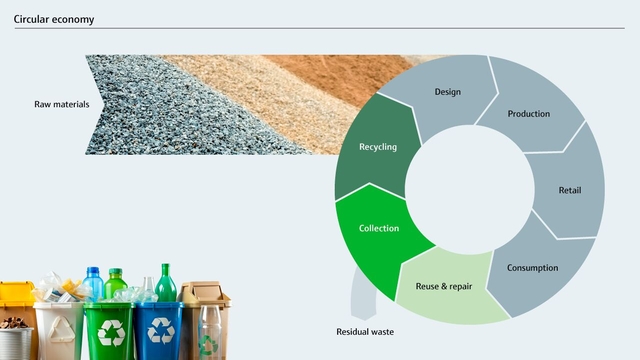Декарбонизация в технологических отраслях
Внедряя инновационные технологии, промышленные предприятия оптимизируют использование энергии, сокращают количество отходов и стремятся к достижению нулевых выбросов УГ

Углекислый газ в двух словах
- Перерабатывающая промышленность имеет широкие возможности для снижения своего углеродного следа с помощью различных методов декарбонизации.
- Такие важнейшие отрасли промышленности, как химическая, сталелитейная, нефтегазовая, горнодобывающая, энергетическая и пищевая, сталкиваются с трудностями на пути декарбонизации, поскольку их основные технологические процессы по своей природе выделяют большое количество парниковых газов.
- Высокие требования к энергопотреблению углеродоемких процессов ставят перед отраслью двойную задачу: сокращение как выбросов в процессе производства, так и ископаемого топлива, которое используется для его питания.
- Технологические отрасли могут достичь нулевого уровня выбросов УГ за счет сокращения отходов производства, использования экологически чистого топлива, перехода на возобновляемые источники энергии и минимизации отходов благодаря практике циркулярной экономики.
- Декарбонизация технологических отраслей требует поэтапного подхода для непрерывного обучения, инноваций, управляемых инвестиций и наращивания темпов продвижения к достижению целей нулевых выбросов УГ
- Взаимодействие с промышленными предприятиями необходимо для продвижения устойчивых практик и сокращения выбросов по всей цепочке создания стоимости.
Призыв к действию
Изменение климата, обусловленное ростом выбросов в атмосферу ПГ, представляет собой насущную глобальную проблему, требующую немедленных и решительных действий по декарбонизации во всех секторах промышленности. Эти усилия необходимы для сокращения выбросов углекислого газа в атмосферу, и хотя некоторые отрасли промышленности по своей природе являются более углеродоемкими, чем другие, каждая из них обладает потенциалом для эффективного снижения выбросов.
Эти способы и технологии включают сокращение выбросов, улавливание углерода, оптимизацию эффективности процессов, переход на альтернативные источники топлива и методы производства. В совокупности эти усилия называются термином «декарбонизация», или снижение воздействия на окружающую среду выбросов углекислого газа в атмосферу. В этой статье рассматриваются все нюансы декарбонизации в обрабатывающей промышленности, изучаются практические стратегии и важнейшая роль сотрудничества и технологий в достижении целей нулевых выбросов УГ в будущем.
Решение проблем, связанных с наиболее углеродоемкими процессами
Некоторые отрасли сталкиваются с особыми проблемами в процессе декарбонизации из-за присущей их основным процессам интенсивности выбросов углерода. Сюда относятся следующие случаи:
- Химическая промышленность и нефтепереработка: Процесс нефтепереработки, в частности производство водорода путем парового метанового риформинга (ПМР) природного газа, является одним из основных источников выбросов углекислого газа. Водород необходим для различных процессов, включая гидроочистку, в ходе которой из продуктов нефтепереработки удаляется сера и другие примеси. Этот же процесс используется для производства аммиака, применяемого в производстве удобрений, и для других важных производственных процессов.
- Производство цемента и извести: Производство цемента и извести включает в себя кальцинацию — высокотемпературный процесс, при котором в качестве побочного продукта выделяется углекислый газ. Широкое использование ископаемых видов топлива, таких как уголь и нефтяной кокс, в таких процессах усугубляет их углеродный след.
- Производство чугуна и стали: При переработке железной руды в железо и сталь, где в основном используются доменные и основные кислородные печи, выделяется значительное количество углекислого газа. Это еще больше осложняется энергоемкостью последующих процессов, таких как непрерывное литье, горячая прокатка и другие операции формования.
- Продукты питания и напитки: Начиная с сельского хозяйства и поиска ингредиентов, заканчивая переработкой, упаковкой и дистрибуцией, сектор производства продуктов питания и напитков в значительной степени использует ископаемое топливо на различных этапах. Это способствует увеличению общего углеродного следа.
Эти отрасли, хотя и являются основополагающими для современного общества, производят значительную часть выбросов ПГ в мире. Только в Соединенных Штатах на их долю приходится более 75% всех промышленных выбросов углекислого газа.

Выводы из анализа данных
На химическую и нефтяную, цементную и известковую, черную металлургию, пищевую промышленность и производство напитков приходится более 75% всех промышленных выбросов углекислого газа.
Источник: ourworldindata.org
Борьба с этими выбросами является не только обязательным экологическим требованием, но и имеет решающее значение для выполнения корпоративных обязательств в области экологии, социальной политики и управления (ESG), а также для обеспечения долгосрочной экономической устойчивости.
Решение взаимосвязанных проблем, связанных с энергоемкостью и технологическими выбросами
Еще одна сложность заключается в том, что многие из этих углеродоемких процессов также являются весьма энергозатратными. В связи с этим перед нами встает двойная задача: сокращение выбросов от самих процессов и одновременно декарбонизация источников энергии, используемых для их питания.
Например, для нефтеперерабатывающих заводов требуется огромное количество энергии для осуществления таких процессов, как гидрокрекинг, атмосферная дистилляция и каталитический крекинг. Зависимость от ископаемых видов топлива для этих энергетических нужд еще больше усиливает общее воздействие процессов на окружающую среду.

Производство цемента и извести в значительной степени зависит от использования вращающихся печей для процесса, называемого кальцинацией, когда известняк и другие минералы нагреваются до высоких температур. При этом выделяется значительное количество углекислого газа, и возраст растения играет важную роль в его эффективности. В старых установках часто отсутствуют современные системы предварительного нагрева, что приводит к снижению рекуперации тепла и общей эффективности энергопотребления и технологического процесса.

Процессы производства железа, стали и других металлов также требуют огромных затрат энергоресурсов на их нагрев, плавку и формовку, зачастую в значительной степени зависящих от ископаемых видов топлива, таких как природный газ и уголь. Для эффективного решения этих взаимосвязанных задач предприятия обрабатывающей промышленности должны внедрить комплексную стратегию по декарбонизации, основанную на четырех ключевых принципах, каждый из которых определяет основные направления для достижения целей нулевых выбросов УГ.
Четыре ключевых принципа для реализации эффективной стратегии декарбонизации
Стратегия
-
Сокращение выбросов
Первым ключевым принципом является минимизация или устранение прямых побочных продуктов процесса производства углекислого газа. Для этого часто требуется смена операционной парадигмы и внедрение инновационных технологий. Оптимизация процессов обычно включает в себя тонкую настройку существующих операций для минимизации потребления энергии и образования отходов. Этого можно достичь с помощью передовых систем управления технологическими процессами, аналитики данных и внедрения лучших практик использования ресурсов. Данные, необходимые для реализации, поступают от приборов, которые в одних случаях уже установлены, а в других — добавлены. Изучение и внедрение альтернативных технологий, которые по своей сути являются менее углеродоемкими, также имеет решающее значение. В частности, можно перейти на возобновляемые электрифицированные источники энергии, где это возможно, использовать более эффективное оборудование и внедрить технологии улавливания, утилизации и хранения углерода (CCUS) для компенсации неизбежных выбросов. Например, основная цель технологии улавливания, утилизации и хранения углерода (CCUS) — предотвратить выброс углекислого газа в атмосферу путем сбора и хранения отходящих газов. В некоторых случаях для значительного сокращения выбросов может потребоваться кардинальное изменение технологического процесса. Сюда можно отнести переход на совершенно новые методы производства, использование другого сырья или изучение альтернативных химических технологий, которые минимизируют или исключают выработку углекислого газа.
-
Переход на экологически чистые виды топлива
Второй ключевой принцип — отказ от ископаемого топлива и использование более чистых альтернативных источников энергии, таких как водород, для производства энергии, чтобы способствовать процессу декарбонизации. Зеленый водород производится путем электролиза с использованием возобновляемых источников энергии, что позволяет получить полностью безуглеродный источник топлива. Он обладает огромным потенциалом для различных применений в перерабатывающей промышленности, включая замену природного газа в высокотемпературных процессах и использование в качестве сырья для производства низкоуглеродных химикатов и топлива. Биотопливо получают из возобновляемых источников, таких как сельскохозяйственные отходы, древесные отходы и другие органические вещества; оно предлагает более устойчивую альтернативу ископаемому топливу. Хотя при их сжигании выделяется углекислый газ, эти процессы считаются углеродно-нейтральными, поскольку углерод был первоначально поглощен из атмосферы во время выращивания сырья.
-
Декарбонизация энергопотребления
Третий ключевой принцип — переход на более чистые источники энергии для всех аспектов энергопотребления, от питания машин и оборудования до теплоснабжения для различных процессов. Интеграция возобновляемых источников энергии, таких как солнечная, ветровая, гидро- и геотермальная, в энергетический баланс имеет решающее значение. Речь может идти о производстве энергии на самом объекте с помощью солнечных электростанций или ветряных турбин, закупке возобновляемой энергии у систем инженерного обеспечения и участии в соглашениях о покупке возобновляемой энергии. Там, где это возможно, значительное сокращение выбросов достигается за счет электрификации — замены традиционных процессов, основанных на использовании ископаемого топлива, альтернативами, которые работают на электричестве. Это особенно актуально для таких процессов, как теплоснабжение и грузоперевозки, где альтернативные электрические технологии становятся все более целесообразными и экономически эффективными.
-
Сокращение отходов для обеспечения циркулярности и эффективности
Четвертый ключевой принцип — минимизация отходов на протяжении всего производственного процесса для снижения энергопотребления и выбросов. Внедрение передовых систем управления технологическими процессами и аналитики данных, основанных на данных, полученных от КИП, может помочь выявить неэффективные процессы и оптимизировать их, чтобы свести к минимуму образование отходов на стадии их возникновения. Кроме того, отходы можно перерабатывать в ценные продукты или сырье для других применений, что способствует развитию циркулярной экономики и снижает нагрузку на окружающую среду, связанную с побочными продуктами. Внедряя этот ключевой принцип, предприятия способствуют переходу от линейной модели «взять-изготовить-утилизировать» к принципам циркулярной экономики, которые сосредоточены на повторном использовании, переработке и сохранении ресурсов в обороте как можно дольше. Эта философия имеет огромное значение для достижения долгосрочной экономической устойчивости.

Создание импульса для долгосрочного успеха с помощью поэтапного подхода
На пути к декарбонизации сложных технологических отраслей лучше всего использовать поэтапный подход, уделяя особое внимание достижению постепенных, но значимых улучшений. Это дает возможность:
- К непрерывному обучению и оптимизации, когда на каждом этапе предоставляются ценные данные и идеи, которые могут быть использованы для совершенствования последующих стратегий. Таким образом обеспечивается постоянное совершенствование и оптимизация усилий по декарбонизации.
- Управлению инвестициями и снижению рисков, что позволяет стратегически распределять инвестиции и минимизировать финансовые риски, связанные с применением масштабных, еще не проверенных технологий.
- Наращиванию темпов и демонстрации прогресса. Успех на начальных этапах способствует укреплению внутреннего и внешнего доверия, привлечению дальнейших инвестиций и ускорению достижения целей нулевых выбросов УГ в будущем.
Например, многие компании, которые предпринимают шаги по внедрению принципов декарбонизации, в настоящее время используют альтернативные виды традиционного ископаемого топлива, такие как природный газ, с более низким уровнем выбросов углерода, известные как переходные виды топлива. Природный газ при сгорании выделяет примерно в два раза меньше углекислого газа, чем уголь, и его можно легко транспортировать в виде сжиженного природного газа (СПГ) в регионы, не имеющие собственных запасов природного газа, в качестве связующего звена для перехода к полностью декарбонизированным источникам энергии.
Ускорение перехода благодаря сотрудничеству и технологическому прогрессу
Декарбонизация обрабатывающей промышленности — это отнюдь не одиночная задача, а скорее коллективные усилия, для которых требуется кооперация и обмен знаниями между отраслями, цепочками создания стоимости и поставщиками технологий. Открытое сотрудничество по вопросам успешных стратегий, возникших проблем и извлеченных уроков может ускорить прогресс и вдохновить на внедрение инноваций во всем секторе.
Выводы из анализа данных
Декарбонизация обрабатывающей промышленности — это отнюдь не одиночная задача, а скорее коллективные усилия, для которых требуется кооперация и обмен знаниями между отраслями, цепочками создания стоимости и поставщиками технологий.
Кроме того, взаимодействие с поставщиками и клиентами для продвижения устойчивых методов и сокращения выбросов по всей цепочке добавленной стоимости имеет решающее значение для достижения целей комплексной декарбонизации. Для ускорения реализации стратегии декарбонизации участники отрасли должны также использовать опыт и инновационные решения технологических компаний, специализирующихся на автоматизации, КИП, аналитике данных, возобновляемых источниках энергии и оптимизации процессов.
Такие компании, как Endress+Hauser, играют в этом процессе ключевую роль, предоставляя современные технологии КИПиА, решения по подключению предприятий к сетям, интеллектуальные данные и глубокое понимание производственных процессов, чтобы помочь компаниям оптимизировать работу, снизить воздействие на окружающую среду и достичь амбициозных целей в области устойчивого развития.
Коллективные усилия на пути к устойчивому будущему
Декарбонизация мировой экономики, особенно обрабатывающей промышленности, — задача монументальная, но вполне достижимая, причем она даст значительный и долгосрочный положительный эффект. Хотя достижение в ближайшее время целей полной декарбонизации нереально для некоторых процессов, стремление к постоянному совершенствованию, внедрение инноваций и развитие сотрудничества проложат путь к экологическому чистому и устойчивому будущему.
Путь к достижению целей нулевых выбросов УГ основывается на многогранном подходе, а именно: минимизация отходов производства, переход на экологически чистое топливо, переход на возобновляемые источники энергии и внедрение практики циркулярной экономики для сокращения генерации отходов. Приняв эти четыре ключевых принципа и используя весь потенциал технологий, коллективной деятельности и непрерывного обучения, перерабатывающая промышленность может сыграть ведущую роль в процессе декарбонизации на пути к достижению целей нулевых выбросов УГ, тем самым обеспечивая более устойчивую окружающую среду для будущих поколений.


